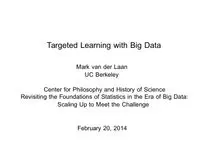
Targeted Learning with Big Data PDF
Preview Targeted Learning with Big Data
Targeted Learning with Big Data Mark van der Laan UC Berkeley Center for Philosophy and History of Science Revisiting the Foundations of Statistics in the Era of Big Data: Scaling Up to Meet the Challenge February 20, 2014 Outline 1 Targeted Learning 2 Two stage methodology: Super Learning+ TMLE 3 Definition of Estimation Problem for Causal Effects of Multiple Time Point Interventions 4 Variable importance analysis examples of Targeted Learning 5 Scaling up Targeted Learning to handle Big Data 6 Concluding remarks Outline 1 Targeted Learning 2 Two stage methodology: Super Learning+ TMLE 3 Definition of Estimation Problem for Causal Effects of Multiple Time Point Interventions 4 Variable importance analysis examples of Targeted Learning 5 Scaling up Targeted Learning to handle Big Data 6 Concluding remarks Foundations of the statistical estimation problem • Observed data: Realizations of random variables with a probability distribution. • Statistical model: Set of possible distributions for the data-generating distribution, defined by actual knowledge about the data. e.g. in an RCT, we know the probability of each subject receiving treatment. • Statistical target parameter: Function of the data-generating distribution that we wish to learn from the data. • Estimator: An a priori-specified algorithm that takes the observed data and returns an estimate of the target parameter. Benchmarked by a dissimilarity-measure (e.g., MSE) w.r.t target parameter. • Inference: Establish limit distribution and corresponding statistical inference. Causal inference • Non-testable assumptions in addition to the assumptions defining the statistical model. (e.g. the “no unmeasured confounders” assumption). • Defines causal quantity and establishes identifiability under these assumptions. • This process generates interesting statistical target parameters. • Allows for causal interpretation of statistical parameter/estimand. • Even if we don’t believe the non-testable causal assumptions, the statistical estimation problem is still the same, and estimands still have valid statistical interpretations. Targeted learning • Define valid (and thus LARGE) statistical semi parametric models and interesting target parameters. • Exactly deals with statistical challenges of high dimensional and large data sets (Big Data). • Avoid reliance on human art and nonrealistic (e.g., parametric) models • Plug-in estimator based on targeted fit of the (relevant part of) data-generating distribution to the parameter of interest • Semiparametric efficient and robust • Statistical inference • Has been applied to: static or dynamic treatments, direct and indirect effects, parameters of MSMs, variable importance analysis in genomics, longitudinal/repeated measures data with time-dependent confounding, censoring/missingness, case-control studies, RCTs, networks. Targeted Learning Book Springer Series in Statistics van der laan & Rose targetedlearningbook.com • First Chapter by R.J.C.M. Starmans ”Models, Inference, and Truth” provides historical philosophical perspective on Targeted Learning. • Discusses the erosion of the notion of model and truth throughout history and the resulting lack of unified approach in statistics. • It stresses the importance of a reconciliation between machine learning and statistical inference, as provided by Targeted Learning. Outline 1 Targeted Learning 2 Two stage methodology: Super Learning+ TMLE 3 Definition of Estimation Problem for Causal Effects of Multiple Time Point Interventions 4 Variable importance analysis examples of Targeted Learning 5 Scaling up Targeted Learning to handle Big Data 6 Concluding remarks Two stage methodology • Super learning (SL) van der Laan et al. (2007),Polley et al. (2012),Polley and van der Laan (2012) • Uses a library of candidate estimators (e.g. multiple parametric models, machine learning algorithms like neural networks, RandomForest, etc.) • Builds data-adaptive weighted combination of estimators using cross validation • Targeted maximum likelihood estimation (TMLE) van der Laan and Rubin (2006) • Updates initial estimate, often a Super Learner, to remove bias for the parameter of interest • Calculates final parameter from updated fit of the data-generating distribution
